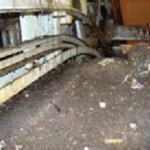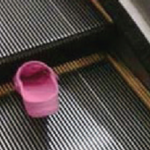An escalator is a type of vertical transportation in the form of a moving staircase which carries people between floors of a building. It consists of a motor-driven chain of individually linked steps on a track which cycle on a pair of tracks which keep them horizontal. Considerations for maintainability when designing the escalator could ensure its optimal required performance while simultaneously minimising costs for maintenance and operations throughout the building’s life cycle.
Design for Maintainability (DfM) Guidelines
| Problem |
Design for Maintainability (DfM) Guidelines |
Escalator and passenger
conveyor related
maintainability issues
 Accumulation of debris within the escalator interior  Footwear getting stuck between steps  Good practice: escalator cordoned off during maintenance operations to prevent unauthorised access |
Design
- Landing area of escalators and passenger conveyors should have a surface that provides a secure foothold for a minimum distance of 0.85m (measured from the root of the comb teeth). (See also AS 1735.1:2016).
- Ensure that the escalator and its surroundings have sufficient and adequate illumination. The supporting structure for escalators and passenger conveyors should be designed as per BS EN 115-1:2008+A1:2010, SS 626:2017.
- Comply with the safety code for elevator design and construction ASME A17.1/CSA B44 —2010, ISO/DIS 22559-1, BS 8899:2016.
- Incorporate anti-climbing, anti-sliding, access restriction and deflecting devices to maintain safe operation (SS 626:2017).
Construction
- Installation of escalators must comply with relevant standards and codes for safety and reliability (BS EN 115-1:2008+A1:2010, SS 626:2017).
- All machinery must be mounted securely and be defect free (e.g. should not have any oil leakage).
- To ensure safe operation without issues due to corrosion and wear and tear, all escalator components should be of durable and reliable make.
- All installed signs, inscriptions and notices should be made of durable materials (BS EN 115-1:2008+A1:2010, SS 626:2017).
Maintenance
- Ensure proper housekeeping of escalator to keep it clean and free of debris.
- Building owner/operator need to conduct monthly maintenance of escalators (including maintenance of safety switches, sensors, emergency stops, and handrails) as per SS 626:2017. (See also BS EN 115-1:2008+A1:2010).
- The annual inspection and testing should be performed by an independent Authorised Examiner (AE).
- Access to the escalator or passenger conveyor should be barred by suitable devices and notices/signage displaying “No access/no entry” should be provided during maintenance, repair works, or inspections (BS EN 115-1:2008+A1:2010, SS 626:2017).
- Adhere to the inspection criteria for safety of escalators as per JIS A 4302:2006. Refer to procedure for ride quality measurements of escalators and moving walks as per BS ISO 18738-2:2003.
|


